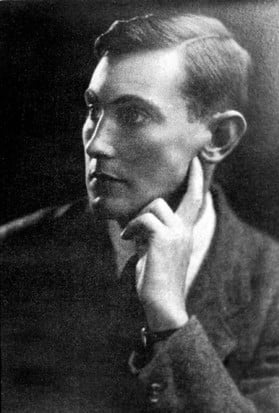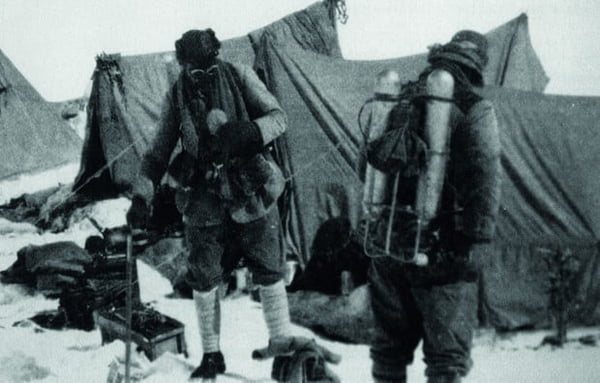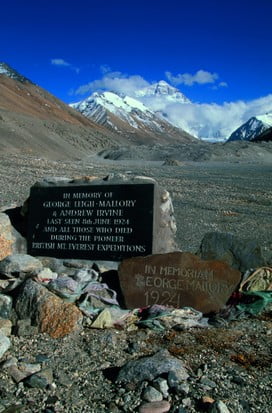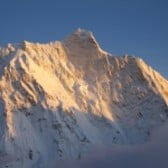
Daily Mountain
48 years, Australia
Mystery on Everest: did Mallory and Irvine reach the summit in 1924?
This article first appeared on http://www.historyextra.com. The original can be read here.
Pat Kinsella explores the high-altitude enigma of George Mallory and Andrew Irvine's climb, which might one day see the history of Earth’s highest mountain rewritten…
Around 1pm on 8 June 1924, George Mallory, one of the era’s leading climbers, and his young companion Andrew Irvine, were spotted as tiny black specks clinging to Everest’s towering Northeast Ridge, just a few hundred metres from the summit. And then the clouds closed in. Irvine has never been seen since, while Mallory’s frozen corpse was finally found in 1999.
 GettyImages
GettyImages
Their unfinished story is mountaineering’s greatest mystery. That they died on the mountain over 90 years ago isn’t in doubt, but what exactly happened up there, on the roof of the world, has been argued about endlessly by alpinists and armchair observers for decades.
Did they reach the top of Everest – 29 years earlier than Edmund Hillary and Sherpa Tenzing Norgay’s accepted first ascent of the planet’s highest peak – before tragedy struck?
When Mallory’s perfectly preserved body was discovered, the photo of his wife that he had sworn to leave on the summit was the only thing missing. That and a Kodak camera carried by the climbers, which remains lost – presumably buried in the ice with the as yet undiscovered remains of Irvine. That camera is the Holy Grail of the adventure world.
The 1924 Everest team
GEORGE MALLORY
A schoolteacher in the midst of mainly military and medical men, expert mountaineer Mallory was the only person to go on all three British Mount Everest expeditions in the 1920s.
ANDREW ‘SANDY’ IRVINE
Fit and strong, Irvine was an elite rower and a gifted engineer but, aged 22, he was the youngest and least experienced member of the 1924 expedition. This made him a surprise choice as Mallory’s partner.
NOEL ODELL
Highly experienced, Odell was a more logical partner, but instead he provided support for Mallory and Irvine’s last chance charge (and thus lived until 1987).
EDWARD NORTON
Expedition leader (after General Charles Bruce retired with malaria), who set a world altitude record of 8,570 metres on the Grand Couloir route.
HOWARD SOMERVELL
Surgeon and mountaineer Somervell survived coughing up a frostbitten piece of his own throat during the summit push.
GEOFFREY BRUCE
Cousin of Charles, he had never climbed a mountain before he set a new altitude record of 8,300 metres on Everest in 1922.
Early expeditions
By 1924, George Mallory, a highly accomplished climber, had already taken part in two expeditions to Everest. He first visited the Himalayas with the 1921 British reconnaissance expedition, organised by the Mount Everest Committee and led by Charles Howard-Bury.
This exploratory mission mapped the region around the mountain in detail for the first time. The team had two experienced mountaineers within their ranks, Alexander Kellas and Harold Raeburn, but Kellas died of a heart attack during the long trek in, and Raeburn fell ill and was forced to retire, making Mallory the expedition’s de facto lead climber. In this capacity, he explored potential approach routes to the summit climb with a team of Sherpas. He was probably the first European to see the Western Cwm at the foot of the Lhotse Face, and his group established a path across the Rongbuk Glacier to the base of the North Face.
 British mountain climber George Mallory. (Image by AFP via Getty Images)
British mountain climber George Mallory. (Image by AFP via Getty Images)
With his former schoolmate Guy Bullock and army surveyor Oliver Wheeler, Mallory then explored East Rongbuk Valley, traversing Lhakpa La pass. The trio became the first people to reach Everest’s North Col, and therefore the first to climb on the mountain proper. They ascended to 7,005 metres, and Mallory picked out a “makeable” route to the summit via the ominous obstacle of what became known as the Second Step. It was late September, however, and in worsening weather conditions, a summit attempt was impossible.
Mallory was soon back with the 1922 British Mount Everest expedition, the first dedicated attempt to scale the highest peak, led by General Charles Bruce. The route they would take was the one Mallory had scouted a year earlier.
It was also the first time that bottled oxygen was employed in climbing. Its use was controversial from the beginning – some climbers considered it improper, and others (including, initially, Mallory) were sceptical of its benefits, especially because the bottles were heavy and unreliable. Three attempts at summiting were made in 1922, all making use of porters who were under-equipped and lacked warm clothing. The first, which took place on 19–21 May without oxygen, saw Mallory, Edward Norton and Howard Somervell reach a new altitude record of 8,225 metres, but bad weather and exhaustion forced them to turn around.
A second attempt was then made using oxygen by George Finch, Geoffrey Bruce and a Gurkha officer called Tejbir, who subsequently turned back. Ascending to the North Col, they made fast progress on the North and Northeast ridges, despite facing severe wind, proving that the oxygen worked. Conditions worsened, however, and Finch and Bruce changed their approach to attempt what’s now known as Norton Couloir. After reaching 8,326 metres (another new record), Bruce’s oxygen system became faulty, and the climb was aborted.
Third time unlucky
An ill-advised third attempt saw seven porters killed during an avalanche on the North Col, which led to Mallory being accused of poor judgment. The climb was abandoned and the team beat a retreat to Darjeeling.
The next expedition was mounted in 1924, with General Bruce again in charge. Somervell, Norton and Geoffrey Bruce were in the team, but Finch had fallen foul of the snobby Mount Everest Committee – mostly for being Australian born. Mallory, unimpressed by the treatment of Finch, had to be talked into going by the British Royal Family.Other climbers included Noel Odell, Bentley Beetham, John de Vars Hazard and an affable 22-year-old called Andrew Irvine, better known as Sandy. The ensemble of English alpinists and local porters departed Darjeeling in March, reached the high border towns of Tibet in early April, and a few weeks later arrived at Rongbuk Monastery, close to their planned base camp. En route, General Bruce succumbed to malaria and leadership passed to Norton.
 Mallory (left) and Irvine in their last known photo. (Image by Alamy)
Mallory (left) and Irvine in their last known photo. (Image by Alamy)
Under his command, Base Camp, Camp II and Camp III (Advanced Base Camp, 6,400 metres) were established between the entrance of the East Rongbuk Glacier and a spot about 1 kilometre below the North Col. After a delay caused by a snowstorm, Norton, Mallory, Somervell and Odell arrived at Advanced Base Camp on 19 May.
On 20 May, the climbers began fixing ropeson the approach slopes to the North Col, establishing Camp IV at 7,000 metres. The weather closed in again, however, stranding Hazard at Camp IV with 12 porters. He managed to descend, but four porters remained behind and were subsequently rescued by Mallory, Norton and Somervell, after which the entire party retreated to Base Camp. The strength and climbing power of many porters had begun to be properly appreciated in 1922, and now their role was more formally recognised, with 15 of the hardiest being designated ‘Tigers’.
Three summit pushes
Three staggered summit pushes were planned. Mallory and Bruce had the first crack, followed by Norton and Somervell, with Irvine and Odell providing support from Camp IV and Hazard hanging tough at Camp III. If the first two attempts, which would both take place without the use of oxygen, were unsuccessful, then the support crew would get their chance, using gas. Accompanied by nine Tiger porters, Mallory and Bruce left Camp IV on 1 June and were immediately strafed by a vicious ice-laced wind whipping across the North Face. Four porters bailed before Camp V was established at 7,700 metres, jettisoning their loads in the process. The camp was erected, but the next day three more porters refused to keep climbing, and the summit push was aborted.
Meanwhile, Norton, Somervell and six Tigers had begun ascending on 2 June, and were startled to meet Mallory and Bruce heading in the other direction not far above Camp IV. Two of their own Tigers turned tail too, but the rest continued to Camp V. The next day, more porters brought up the materials to erect Camp VI, which was successfully achieved before all porters were sent back to Camp IV.
Norton and Somervell spent an uncomfortable night at 8,170 metres, well within the infamous Death Zone. When dawn finally broke on 4 June, the two Englishmen began preparing for their final summit push, melting snow for water. One bottle was spilled, which delayed their departure by an hour, but they set off at 6.40am in perfect conditions.
After scaling 200 metres of the North Ridge, they traversed the North Face diagonally. By midday, Somervell, who was suffering from a wracking cough, was unable to continue. Norton carried on solo, clambering tenaciously through the Great Couloir, a gully that leads to the eastern foot of the summit pyramid, now known as Norton Couloir after his heroic effort. Eventually, at 8,570 metres, he was forced to concede defeat as the terrain became too technical to tackle in his exhausted state. He was 280 metres shy of the summit, but had set a new altitude record that remained unbroken for 28 years – at least, not by anyone who survived.
Norton rejoined Somervell and the two men slowly began downclimbing. During his descent, Somervell felt his throat closing. Thinking he was about to die, he sat down to await his fate.
Later, he wrote: “Finally, I pressed my chest with both hands, gave one last almighty push – and the obstruction came up. What a relief! Coughing up a little blood, I once more breathed really freely – more freely than I had done for some days. Though the pain was intense, I was a new man.”
The blockage was part of the lining of Somervell’s throat, which had become badly frostbitten, detached and was choking him to death. It was dark by the time they reached Camp IV, but Mallory was waiting with bottles of oxygen and a new plan.
A final attempt
Mallory proposed making a final attempt with Irvine, who possessed good technical skills with oxygen bottles and was as “strong as an ox” to boot. Norton acquiesced, despite Irvine’s inexperience at such extreme altitude. Accompanied by five porters, Mallory and Irvine dashed up through the camps. They reached Camp VI on 7 June, sending the porters down to meet Odell, who had climbed to Camp V to provide support. The porters carried a message advising Odell to look out for them “either crossing the rock band under the pyramid or going up skyline at 8am” on 8 June.
 A memorial area to George Mallory and Andrew Irvine at the Rongbuk Base Camp. (Image by Alamy)
A memorial area to George Mallory and Andrew Irvine at the Rongbuk Base Camp. (Image by Alamy)
Odell began scanning the mountainside the following morning, but the ridge was obscured by mist. At 12.50pm, the ethereal curtain parted and he spied two dark dots just below the Northeast Ridge. He watched as they quickly climbed what he thought was the Second Step to the ridge, and then the mist returned. Concerned that they were well behind schedule, Odell ascended to Camp VI, which he discovered in disarray. As snow began to fall, he went outside and began calling for the men, hoping to guide them towards the camp.
Forced inside by the snowstorm, Odell stayed until conditions cleared at 4pm, and then vacated the high camp, which would only accommodate two men, descending to Camp IV. He returned the next day with two porters and stayed overnight before continuing alone to Camp VI, where nothing had changed. Venturing further, he still found no sign of his missing comrades. Arranging two sleeping bags into a ‘T’ shape, which signalled to those below that ‘No Trace’ had been found, he descended to Camp IV. The surviving climbers left the still unconquered mountain on 11 June, with an enigma buried high on its frozen flanks.
The Mallory/Irvine expedition: what happened next?
In 1979, Chinese climber Wang Hongbao told a fellow mountaineer that he’d seen the body of an Englishman during an earlier (1975) expedition. Wang was killed in an avalanche the day after revealing this information, and the corpse – thought to be Irvine’s – has never been located. Mallory’s body, frozen in a position of self-arrest, was discovered in 1999 during an expedition dedicated to looking for the missing men. Goraks, the black ravens that haunt the Himalayas, had hollowed out the body, but the corpse was intact enough to tell a few intriguing tales. Mallory’s right elbow and leg were broken, and he had a severe head injury, the likely cause of death. His rib cage was compressed by a rope, which suggests he was attached to Irvine when both men fell. His snow goggles were in his pocket, so presumably he was descending in the dark, and missing from Mallory’s body was the photo of his wife, Ruth, that he’d promised to leave at the summit.





